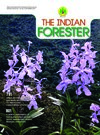Endangered Medicinal Plant Taxus baccata Hook. F. and Natural Regeneration status in Himachal Pradesh, India
DOI:
https://doi.org/10.36808/if/2018/v144i9/132676Keywords:
Yew, Natural Regeneration, Endangered, Medicinal Plant, Himachal Pradesh, Himalaya.Abstract
In present study, natural regeneration status of Taxus baccata along with other associated tree species was assessed in three forest divisions of Himachal Pradesh, North Western Himalaya, India. Two sites were selected in each division and were further divided into lower (2500-2700m) and upper (2700-2900m) elevations. The results revealed that the recruitments of Taxus baccata are good enough at higher elevations as compared to lower elevations, but there is no any established regeneration in all three forest divisions. The incidence of over-harvesting and other anthropogenic pressures was comparatively higher at lower elevations, leading to poor regeneration of the species. Associated species showed better recruitments and established regeneration as compared to that of Taxus baccata, which attributed that natural regeneration of this species is being fatally hampered due to exclusive over exploitation. The study suggests that there is an immediate need to protect Taxus bearing forests from harvesting (lopping, peeling bark, etc.), grazing and other destructive activities. The species regenerates poorly from seed. By means of efficient biotechnological tools, artificial regeneration of the species should be promoted in nursery to develop mass scale healthy planting materials. Besides in-situ conservation and management, mass scale afforestation of the species with the participation of local communities in protected forest areas particularly at religious forests need to be done.References
Anon. (2004). Participatory forest management implication for policy and human resources development in Hind Kush Himalayas. ICIMOD. Kathmandu, Nepal, (6): 79.
Assmann E. (1970). The principals of forest yield study. 2nd Ed. Oxford pergamon Press Ltd. 506 p.
Chacko V.J. (1965). A manual of sampling technique for forest surveys. Manager Publications, Delhi, 172 p.
Champion H.G. and Seth S.K. (1968). A revised survey of forests types of India. Manager publication Delhi, p. 404.
Champion H.G. (1935). Silvicultural research manual for use in India. Vol. I. The experimental manual. Government of India. Press Delhi, p. 110.
Chaturvedi A.N. and Khanna L.S. (1982). Forest Mensuration. International Book Distributors, Dehradun, India, 403 p.
Cleark F.R. (1979). Comparison of regeneration survey design utilization plot sizes. Typed mass.Ontario Ministry of Natural Resource, Toronto, 26 p.
Garcia D., Zamora R., Hodar J.A., Gomes J.M. and Castro J. (2000). Yew (Taxusbaccata) regeneration is facilitated by fleshyfruited shrubs in Mediterranean environments. Biological Conservation, 95(1): 31-38.
Godon D.T. (1970). Natural regeneration of white and red fir. Us Forest Research Paper No. PSW, 58: 32.
Gupta N.K. (1996). Appraisal of vegetational pattern of Shimla district through remote sensing with special reference to the ecology of fir-spruce forests. Ph.D. Thesis, UHF, Solan (H.P.), India, 113 p.
IUCN (2008). Red List of Threatened species, www.iucnredlist.org.
Jackson M.L. (1973). Soil chemical analysis. Prentice Hall of India Pvt. Ltd., New Delhi.
Jha M.N., Rathore R.K. and Pande P. (1984). Soil factors affecting natural regeneration of silver firand spruce in Himachal Pradesh. Indian Forester, 110 (3): 293-298.
Kopp R. (1991). Regeneration dynamics of Taxus and weed baccata in the yew forest nature reserveat Gottingen. Fprstarchiv, 62 (5): 188-191.
Menon A.R.R. and Balasubramanyam K. (1985). Species relations studies in moist deciduous forests of Trichur Forest Division (Kerala). KFRI, Research report, 32: 194.
Misra R. (1968). Ecology workbook. Oxford and IBH Publishers, India, 241 p.
Pant S. and Samant S.S. (2008). Population Ecology of the Endangered Himalayan Yew in Khokhan Wildlife Sanctuary of North Western Himalaya for Conservation Management. J. of Mountain Science, 5: 257-264.
Phillips B.A. (1959). Methods of vegetation survey. Heveryholt and Co. Inc.
Rao G.R. (1998). Study on dynamics of herbage layer in pine and Khair based natural silvipastoral system in North West Himalaya. Ph.D. Thesis submitted to Dr. Y.S. Parmar UHF, Solan (H.P.).
Raunkiaer C. (1934). The life forms of plants and statistical plant geography. The collected paper of C. Raunkiaer, Clarendon, Oxford, 632 p.
Rikhari H.C., Palni L.M.S., Sharma S. and Nandi S.K. (1998). Himalayan yew: stand structure,canopy damage, regeneration and conservation strategy. Environmental Conservation, 25 (4): 334-341.
Shamet G.S. and Gupta N.K. (2005). Survey, regeneration and planting studies in yew (Taxus baccata): an endangered medicinal species of Himalaya. Report of National Medicinal Plant Board, GOI, 25 p.
Singh V., Bhagat S. and Arya S.R. (1987), Litter fall and natural regeneration of spruce and silverfir. Indian Forester, 113 (9): 616-621.
Subbiah B.V. and Asija G.L. (1956). A rapid procedure for the estimation of available nitrogen in soils. Current Science, 25: 259-260.
Walkley A.J. and Black I.A. (1954). Estimation of soil organic carbon chronic acid titration method. Soil Science, 37: 29-28.
Downloads
Downloads
Published
How to Cite
Issue
Section
License
Unless otherwise stated, copyright or similar rights in all materials presented on the site, including graphical images, are owned by Indian Forester.





